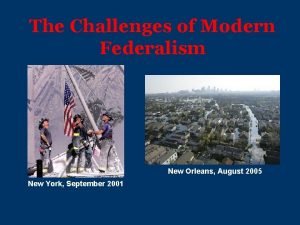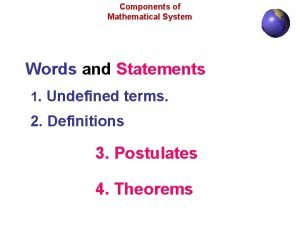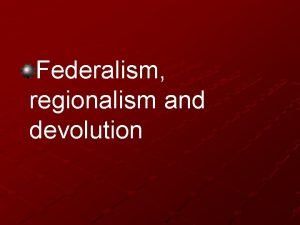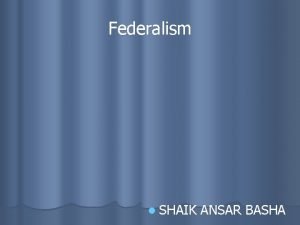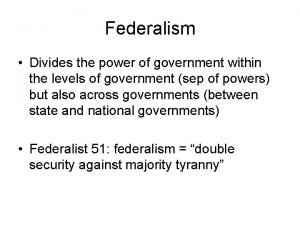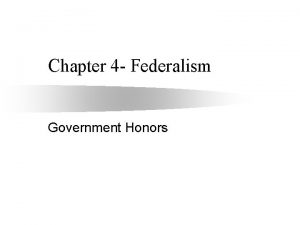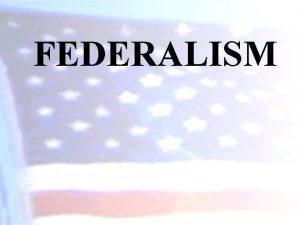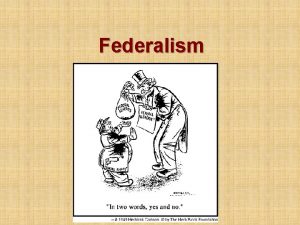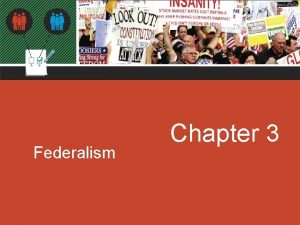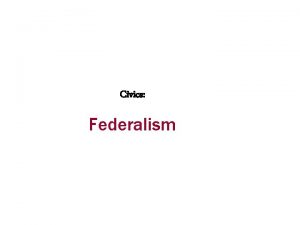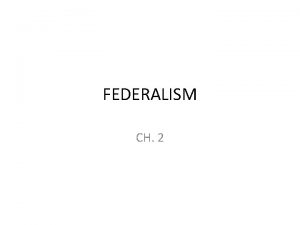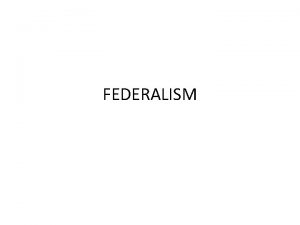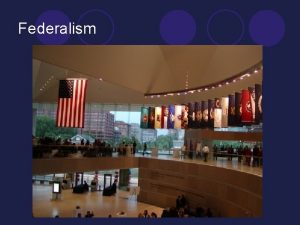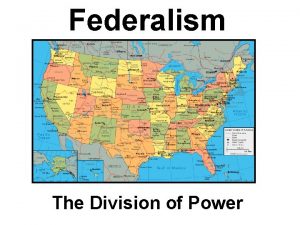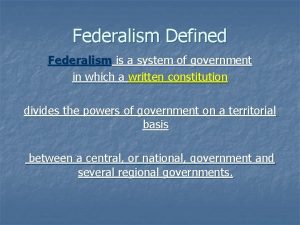Federalism Defined Federalism is a political system in













- Slides: 13

Federalism Defined Federalism is a political system in which power is divided and shared between the national/central government and the states (regional units) in order to limit the power of government.

1. The Roots of the Federal System • The Framers worked to create a political system that was halfway between the failed confederation of the Articles of Confederation and the tyrannical unitary system of Great Britain. • The three major arguments for federalism are: 1. the prevention of tyranny; 2. the provision for increased participation in politics; 3. and the use of the states as testing grounds or laboratories for new policies and programs.



1. The Evolution and Development of Federalism • The allocation of powers in our federal system has changed dramatically over the years. • The Supreme Court in its role as interpreter of constitution has been a major player in the redefinition of our Federal system. – Mc. Culloch v. Maryland (1819) – Gibbons v. Ogden (1824) – Dred Scott v. Sandford (1857)

Cooperative Federalism • Prior to the 1930 s, many scholars used the analogy of a layer cake to describe federalism. – Each layer had clearly defined powers and responsibilities. • After the New Deal, the analogy of a marble cake seemed more appropriate because the lines of authority were much more mixed. • This marble cake federalism is often called cooperative federalism and has a much more powerful national government. • States have a cooperative role, as did many cities.

Federal Grant-in-Aid Outlays 1980 - 2012

Creative Federalism • Federal grants: allocation of federal money to the states for a specific purpose. • Federal leadership saw these grants as a way to compel individual states to behave in ways desired by the national government. If the states refused to cooperate with the federal government, it would withhold funds.

The Reagan Revolution Shortly after taking office in 1980, former California Governor Ronald Reagan set to work enacting his vision of the “New Federalism” by drastically cutting federal domestic programs and income taxes in an attempt to reestablish the primacy of the states. For the first time in thirty years, federal aid to state and local governments declined.

The Devolution Revolution Growth in power of the national government during the Clinton administration: • Preemption: allows the national government to override state or local actions in certain areas. • Unfunded mandates: laws that require states to comply with federal regulations or face civil and/or criminal penalties.

Budget shortfalls by state

1. Federalism and the Supreme Court • By the 1980 s and 1990 s, many Americans began to think that the national government was too big, too strong, and too distant to understand their concerns. • The Supreme Court, once again, played a role in this new evolution of federalism. – For example: Since 1989, the Court has been allowing states to introduce limitations on the right to an abortion.

State-by-State Report Card on Access to Abortion • Abortion laws state by state
 Cooperative federalism political cartoon
Cooperative federalism political cartoon Collection of well defined object
Collection of well defined object Ubicom system is mythological defined as
Ubicom system is mythological defined as Components of geometry
Components of geometry Two types of federalism
Two types of federalism Section quiz 4-3 developing federalism
Section quiz 4-3 developing federalism Federalists and anti-federalists
Federalists and anti-federalists Difference between regionalism and federalism in a sentence
Difference between regionalism and federalism in a sentence Federalism
Federalism Federalists definition
Federalists definition Types of federalism
Types of federalism Basic premise of federalism
Basic premise of federalism Examples of federalism
Examples of federalism Federalism
Federalism
